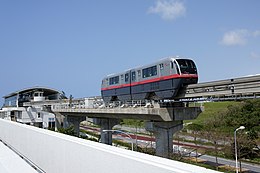Okinawa Urban Monorail
Public transit line serving the cities of Naha and Urasoe, Okinawa, Japan From Wikipedia, the free encyclopedia
The Okinawa Urban Monorail (沖縄都市モノレール, Okinawa Toshi Monorēru), also known as Yui Rail (ゆいレール, Yui Rēru), is a monorail line serving the cities of Naha and Urasoe, Okinawa, Japan. Operated by Okinawa Urban Monorail, Inc. (沖縄都市モノレール株式会社, Okinawa Toshi Monorēru Kabushiki-gaisha), it opened on 10 August 2003, and is the only public rail system in Okinawa Prefecture. Yui Rail is the first rail line on Okinawa since World War II. As Okinawa is the island of Japan lying farthest to the south and west that has an active rail line, Akamine Station and Naha Airport Station, the southernmost and westernmost rail stations in Japan respectively, lie on this line. The line supports payment via paper tickets or OKICA, the local contactless smart card; additional support for the ten major Japanese IC cards (such as Suica and SUGOCA) began on 10 March 2020.[3][4]
 | |
| Industry | Rail transport |
|---|---|
| Founded | 10 August 2003 |
| Headquarters | |
Area served | Naha and Urasoe Okinawa Prefecture, Japan |
| Services | Monorail |
| Owner | Okinawa Urban Monorail, Inc. |
| Website | www |
| Okinawa Urban Monorail | |||
|---|---|---|---|
 1000 series train on the Okinawa Urban Monorail | |||
| Overview | |||
| Locale | Naha and Urasoe Okinawa Prefecture, Japan | ||
| Transit type | Straddle-beam monorail | ||
| Number of lines | 1 | ||
| Number of stations | 19 | ||
| Daily ridership | 49,716 per day (2017) | ||
| Operation | |||
| Began operation | 10 August 2003 | ||
| Operator(s) | Okinawa Urban Monorail, Inc. | ||
| Technical | |||
| System length | 17 km (11 mi)[1] | ||
| Electrification | 1,500 V DC | ||
| |||
Yui Rail - Stations | |||||||||||||||||||||||||||||||||||||||||||||||||||||||||||||||||||||||||||||||||||||||||||||||||||||||||||||||||||||||||||||||||||||||||||||||||||
|---|---|---|---|---|---|---|---|---|---|---|---|---|---|---|---|---|---|---|---|---|---|---|---|---|---|---|---|---|---|---|---|---|---|---|---|---|---|---|---|---|---|---|---|---|---|---|---|---|---|---|---|---|---|---|---|---|---|---|---|---|---|---|---|---|---|---|---|---|---|---|---|---|---|---|---|---|---|---|---|---|---|---|---|---|---|---|---|---|---|---|---|---|---|---|---|---|---|---|---|---|---|---|---|---|---|---|---|---|---|---|---|---|---|---|---|---|---|---|---|---|---|---|---|---|---|---|---|---|---|---|---|---|---|---|---|---|---|---|---|---|---|---|---|---|---|---|---|
| |||||||||||||||||||||||||||||||||||||||||||||||||||||||||||||||||||||||||||||||||||||||||||||||||||||||||||||||||||||||||||||||||||||||||||||||||||
Yui Rail
The monorail's "Yui Rail" brand name and logo were selected in a public competition.[5] It consists of 19 stations, from Naha Airport in the west to Tedako-Uranishi in the east, running via Naha.[6] The average distance between stations is 0.93 kilometers (0.58 mi). It takes 37 minutes and costs ¥370[6] to traverse its 17 km (11 mi) length.[1]
Trains (made by Hitachi Rail and Kawasaki Heavy Industries Rolling Stock Company under the former's monorail lineup) are made up of two or three cars, with 65 seats and a total capacity of 165 people.[1] Trains run on an elevated track between 8 and 20 meters (26 and 66 ft) above the ground, with a top speed of 65 km/h (40 mph) and an actual average speed of 28 km/h (17 mph) counting stops.[1]
In August 2023, two new 3-car trains were added. The operator plans to increase the number of 3-car trains to nine by 2025.[7]
As of 2020, Yui Rail has been free-to-ride for high school students in the prefecture.[8]
Urasoe extension
After lengthy deliberation of possible route options, the monorail corporation applied for construction permission for a 4.1 kilometers (2.5 mi), 4-station extension from Shuri Station to Tedako-Uranishi Station (Urasoe City) in August 2011.[9] Permission was granted on 26 January 2012, with construction planned to start in March 2013. Revenue operation along the extension started on 1 October 2019, using a revised schedule with extended rush hour headways for opening day.[10][11][12]
Preliminary ridership data from the first week showed that year-on-year ridership was up after the extension opened on 1 October.[13]
Stations
| Station No. |
Station name | Distance | Total distance |
Location | ||
|---|---|---|---|---|---|---|
| English | Japanese | |||||
| 1 | Naha Airport | 那覇空港 | - | 0.00 km (0 mi) | Naha | |
| 2 | Akamine | 赤嶺 | 1.95 km (1.21 mi) | 1.95 km (1.21 mi) | ||
| 3 | Oroku | 小禄 | 0.76 km (0.47 mi) | 2.71 km (1.68 mi) | ||
| 4 | Onoyama Park | 奥武山公園 | 0.97 km (0.60 mi) | 3.68 km (2.29 mi) | ||
| 5 | Tsubogawa | 壺川 | 0.84 km (0.52 mi) | 4.52 km (2.81 mi) | ||
| 6 | Asahibashi | 旭橋 | 0.81 km (0.50 mi) | 5.33 km (3.31 mi) | ||
| 7 | Prefectural Office | 県庁前 | 0.58 km (0.36 mi) | 5.91 km (3.67 mi) | ||
| 8 | Miebashi | 美栄橋 | 0.72 km (0.45 mi) | 6.63 km (4.12 mi) | ||
| 9 | Makishi | 牧志 | 0.98 km (0.61 mi) | 7.61 km (4.73 mi) | ||
| 10 | Asato | 安里 | 0.59 km (0.37 mi) | 8.2 km (5.1 mi) | ||
| 11 | Omoromachi | おもろまち | 0.75 km (0.47 mi) | 8.95 km (5.56 mi) | ||
| 12 | Furujima | 古島 | 1.01 km (0.63 mi) | 9.96 km (6.19 mi) | ||
| 13 | Naha City Hospital | 市立病院前 | 0.92 km (0.57 mi) | 10.88 km (6.76 mi) | ||
| 14 | Gibo | 儀保 | 0.96 km (0.60 mi) | 11.84 km (7.36 mi) | ||
| 15 | Shuri | 首里 | 1.00 km (0.62 mi) | 12.84 km (7.98 mi) | ||
| 16 | Ishimine | 石嶺 | 1.06 km (0.66 mi) | 13.90 km (8.64 mi) | ||
| 17 | Kyozuka | 経塚 | 1.20 km (0.75 mi) | 15.10 km (9.38 mi) | Urasoe | |
| 18 | Urasoe-Maeda | 浦添前田 | 1.00 km (0.62 mi) | 16.10 km (10.00 mi) | ||
| 19 | Tedako-Uranishi | てだこ浦西 | 1.00 km (0.62 mi) | 17.10 km (10.63 mi) | ||
See also
References
External links
Wikiwand - on
Seamless Wikipedia browsing. On steroids.

